Abstract
Global climate change has intensified the heterogeneity of precipitation regimes in subtropical regions, and the increasing frequency of extreme drought events poses a significant threat to biogeochemical cycling in forest ecosystems. Yet, the pathways by which reduced precipitation regulates deadwood decomposition and thereby influences soil nutrient pools remain poorly resolved. Here, we investigated a Cunninghamia lanceolata (Lamb.) Hook. plantation in subtropical China under ambient precipitation (CK) and precipitation reduction treatments of 30%, 50%, and 80%, systematically examining how reduced precipitation alters the chemical properties of deadwood substrates and, in turn, soil nutrient status. Our findings reveal that (1) as precipitation declined, soil water content decreased significantly (p < 0.01), while deadwood pH declined and total organic carbon (TOC), nonstructural carbohydrates (NSCs), and lignin content markedly accumulated (p < 0.01); (2) these shifts in deadwood chemistry affected feedback mechanisms, leading to the suppression of soil nutrient pools: extreme drought (80% reduction) significantly reduced soil TOC, dissolved organic carbon (DOC), total nitrogen (TN), and total phosphorus (TP) (p < 0.01) and inhibited N and P mineralization, whereas the 30% reduction treatment elicited a transient increase in soil microbial biomass carbon (MBC), indicative of microbial acclimation to mild water stress; and (3) principal component analysis (PCA) showed that the 80% reduction treatment drove lignin accumulation in deadwood, while the 30% reduction treatment exerted the greatest influence on soil DOC, TOC, and MBC; partial least squares path modeling (PLS-PM) further demonstrated that soil water content and deadwood substrate properties (pH, lignin, soluble sugars, TOC, C/N, and lignin/N) were strongly negatively correlated (r = −0.9051, p < 0.01), and that deadwood chemistry was, in turn, negatively correlated with soil nutrient variables (pH, TOC, DOC, MBC, TP, TN, and dissolved organic nitrogen [DON]; r = −0.8056, p < 0.01). Together, these results indicate that precipitation reduction—by drying soils—profoundly modifies deadwood chemical composition (lignin accumulation and NSC retention) and thereby, via slowed organic-matter mineralization, constrains soil nutrient release and accumulation. This work provides a mechanistic framework for understanding forest carbon–nitrogen cycling under climate change.
1. Introduction
Global climate change significantly impacts the hydrological cycles and biogeochemical processes of terrestrial ecosystems. The increasingly pronounced spatiotemporal heterogeneity of precipitation regimes has emerged as a critical threat to the functional stability of forest ecosystems [1,2]. The IPCC Sixth Assessment Report projects that both the frequency and intensity of extreme drought events in mid-latitude regions will continue to rise [2], posing a severe challenge to the decomposition of forest litter and the cycling of soil nutrients—processes that fundamentally depend on water availability. While extensive research has documented drought-induced reductions in tree growth, leaf litter decomposition, and soil respiration [3,4,5], the specific mechanisms by which reduced precipitation regulates deadwood chemical dynamics and their cascading effects on soil nutrient cycling remain poorly resolved.
Previous studies have primarily focused on foliar litter decomposition under drought [6,7], overlooking deadwood as a critical long-term carbon reservoir that may respond differently due to its structural complexity and slower decay rates [8,9]. For instance, Bradford et al. [8] highlighted that climate variables poorly predict regional-scale wood decomposition, suggesting uncharacterized biotic and abiotic interactions. Moreover, while lignin accumulation under moisture stress is known to inhibit decomposition [10], how this process affects the feedback mechanisms underlying the inhibition of soil nitrogen and phosphorus availability remains unclear [11,12]. It is noteworthy that decomposition rates vary substantially among tree species due to differences in wood chemistry [13]. Cunninghamia lanceolata is characterized by high lignin content and low nitrogen concentration, typical of coniferous species. These traits contribute to slower decomposition compared to broadleaved species [14], potentially amplifying drought effects on nutrient release [15].
Soil water content is the principal regulator of deadwood decay: fluctuations in water availability directly influence the activity of white-rot fungi and the secretion of lignin-degrading enzymes (e.g., lignin peroxidases), thereby controlling the degradation rates of structural carbohydrates like lignin and cellulose [16,17]. Under drought, constrained microbial metabolism leads to the accumulation of nonstructural carbohydrates (NSCs) and delays in organic-matter mineralization [18,19]. Deadwood, as a major carbon reservoir of lignified residues in forest ecosystems, undergoes decomposition that not only governs the release rates of carbon, nitrogen, and phosphorus but also drives the long-term balance of ecosystem nutrient cycling by altering soil microenvironments [9,20,21]. Despite its importance, the mechanisms by which reduced precipitation influences deadwood decay remain insufficiently understood.
Forest litter and deadwood decomposition are central processes driving ecosystem nutrient cycling. Deadwood, due to its slow decay rate and substantial carbon stocks, serves as a critical long-term carbon reservoir [8,22]. During the decomposition of deadwood, the dynamic balance between structural carbohydrates (e.g., lignin and cellulose) and nonstructural carbohydrates (e.g., soluble sugars and starch) plays a pivotal role in controlling the release, transformation, and retention of soil nutrients [21]. Lignin, as a recalcitrant component of deadwood, is primarily degraded by lignin peroxidases secreted by white-rot fungi [16]. Reduced precipitation lowers soil water content, which inhibits aerobic microbial activity, delays lignin decomposition, and consequently postpones the release of carbon and nitrogen [17]. Cellulose, the predominant structural carbohydrate in deadwood, yields degradation products such as glucose, which provide essential energy sources for soil microorganisms [23]. Under water content-limited conditions, diminished cellulase activity retards cellulose breakdown, restricts microbially available carbon, suppresses soil MBC accumulation, and indirectly impedes organic-matter mineralization [24]. As nonstructural carbohydrates (NSCs), soluble sugars and starch tend to accumulate within deadwood under drought conditions [18,19]. Upon rewetting, these NSCs are rapidly metabolized, triggering a transient surge in microbial activity and promoting the release of DOC and DON [25]. Thus, by altering soil water content regimes, precipitation reduction may modify the chemical properties of deadwood substrates and, consequently, alter soil nutrient content. However, a systematic elucidation of the mechanisms by which drought-induced changes in soil water content regulate deadwood chemistry and, in turn, influence soil nutrient dynamics remains lacking.
This study focuses on typical subtropical Cunninghamia lanceolata plantations in China, analyzing the effects of various precipitation reduction treatments (30%, 50%, and 80% reduction) on the chemical properties of decaying wood substrates, including pH, TOC, TN, lignin, cellulose, soluble sugars, and starch. Furthermore, it elucidates the interaction mechanisms between the chemical properties of decaying wood substrates and key soil nutrients (TOC, DOC, MBC, TN, and TP) under these precipitation reduction treatments. The central scientific questions addressed in this study are as follows: 1. How does reduced precipitation, through alterations in soil water content, regulate the chemical composition of deadwood substrates? 2. How do decomposition-driven chemical shifts in deadwood influence the feedback mechanisms underlying soil nutrient dynamics? Accordingly, we hypothesize that 1. precipitation reduction will significantly decrease soil water content, leading to a higher proportion of recalcitrant components (e.g., lignin) in deadwood and the accumulation of nonstructural carbohydrates (NSCs; soluble sugars and starch) due to constrained microbial utilization, and 2. elevated concentrations of lignin and NSCs in deadwood substrates will inhibit the accumulation of soil nutrients.
2. Materials and Methods
2.1. Research Site
The experiment was conducted within the Lushan National Nature Reserve, located in Jiangxi Province, China (29°25′–29°41′ N, 115°52′–116°06′ E) (Figure 1). This region is representative of subtropical evergreen broadleaved forests in eastern China, which cover approximately 25% of China′s forest area and are critical for regional carbon sequestration [26]. The study forest is classified as a Cunninghamia lanceolata plantation under the International Geosphere–Biosphere Programme (IGBP) forest category “Evergreen Needleleaf Forests” (code 1). The plantation is monospecific, with C. lanceolata constituting > 95% of the canopy layer. Understory vegetation is dominated by Woodwardia japonica (L. f.) Sm. (fern) and Clerodendrum cyrtophyllum Turcz. (shrub), accounting for 80% of understory biomass. This species composition is typical of managed subtropical plantations in southern China. Soils in the area are classified as ferrallitic red soils, developed from Quaternary red clay parent material. The characteristics of soil chemical properties are illustrated in Table 1. Monthly mean precipitation and air temperature during the study period (January 2022–December 2023) are illustrated in Figure 2.
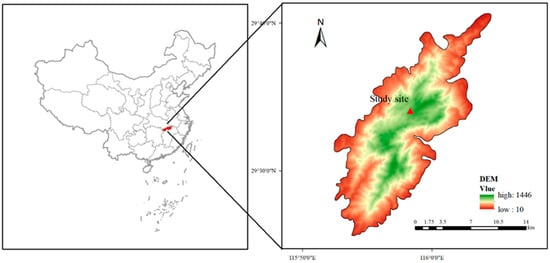
Figure 1.
Location of the study site.

Table 1.
Soil chemical characteristics prior to the experiment (October 2021). DOC: dissolved organic carbon, DON: dissolved organic nitrogen, MBC: microbial biomass carbon.
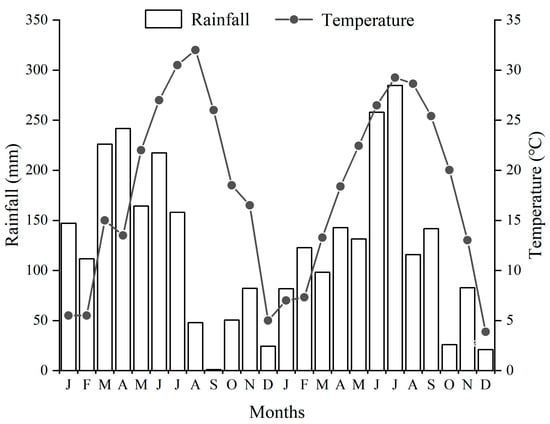
Figure 2.
Average monthly rainfall and air temperature from January 2022 to December 2023 in the study region. J, F, M, etc., abbreviations for each month (from January 2022 to December 2023, twenty-four months in total).
2.2. Experiment Design
The experiment was conducted at the Lushan Forest Ecosystem National Observation Research Station in Jiangxi Province, utilizing a randomized complete block design comprising three blocks. Within each block, 4 precipitation treatments were applied, namely ambient precipitation (control) and reductions of 30%, 50%, and 80%, resulting in a total of 12 experimental plots. Each plot measured 5 m × 5 m and was enclosed by rigid plastic panels 1.1 m in height, of which 0.7 m was buried and 0.4 m protruded aboveground, to effectively intercept subsurface flow and surface runoff. Aboveground precipitation exclusion was achieved by installing plastic tubing across the plot canopy. The design of the rainfall interception apparatus is illustrated in Figure 3. In October 2021, 25-year-old Cunninghamia lanceolata disks (5 cm thick, 16 cm in diameter) were placed in each plot, with two disks allocated per precipitation exclusion unit. The chemical characteristics of the fallen tree soil and disks are shown in Table 1 and Table 2. A schematic diagram of the study design is shown in Figure 4.

Figure 3.
Rainfall interception devices: (1) intercepting 30% of precipitation, p-30%; (2) intercepting 50% of precipitation, p-50%; (3) intercepting 80% of precipitation, p-80%.

Table 2.
Deadwood debris chemical characteristics prior to the experiment (October 2021). TOC: total organic carbon, TN: total nitrogen, TP: total phosphorus.
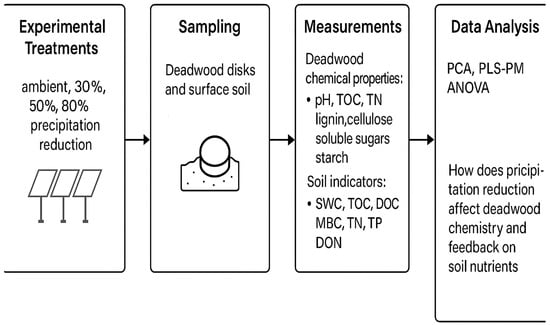
Figure 4.
Schematic flowchart of the experimental design assessing the effects of precipitation reduction on Cunninghamia lanceolata deadwood chemistry and soil nutrient feedback mechanisms.
2.3. Sample Collection and Determination
In January 2024, deadwood disks and the surface soil (0–20 cm depth) were collected. The deadwood samples were air-dried, pulverized using a grinder, and passed through a 0.149 mm sieve for the analysis of TOC, TN, TP, lignin, cellulose, soluble sugars, and starch. Soil samples were manually cleared of debris (including stones and roots), sieved through a 2 mm mesh and subsequently divided into two subsamples: one was stored at 4 °C for the determination of DOC, DON, and MBC; the other was air-dried for the measurement of pH, TOC, TN, and TP. Soil water content (0–20 cm) was monitored monthly using a soil moisture meter (Delta-T Devices, Cambridge, UK; model HH2). Values in Table 3 represent the arithmetic means of 27 monthly measurements per treatment plot.

Table 3.
Average topsoil (0–20 cm) water content of plots under different precipitation reduction treatments (October 2021–January 2024). Different uppercase letters indicate significant differences among treatments (p < 0.05).
TOC in deadwood and soil was determined using the dichromate oxidation–external heating method (H2SO4–K2Cr2O7) (Jiangxi Ganyi Instrument Co., Ltd., Ganzhou, China). Coarse deadwood fragments and TN were digested with concentrated sulfuric acid and 72% perchloric acid (H2SO4–72% HClO4) (Jiangxi Ganyi Instrument Co., Ltd., Ganzhou, China), as well as concentrated sulfuric acid combined with 300 g L−1 hydrogen peroxide (H2SO4–300 g L−1 H2O2) (Jiangxi Ganyi Instrument Co., Ltd., Ganzhou, China), and were quantified through an automated intelligent chemical analyzer (Westco Scientific Instruments, Brookfield, CT, USA). TP was similarly digested (H2SO4–72% HClO4; H2SO4–300 g L−1 H2O2) (Jiangxi Ganyi Instrument Co., Ltd., Ganzhou, China) and measured using the molybdenum–antimony colorimetric method with a UV-6300 spectrophotometer (MAPADA, Shanghai, China). The pH of deadwood and soil (1:2.5 w/v in H2O) was measured with a Mettler S20P-K pH meter (Mettler-Toledo, Columbus, OH, USA). Cellulose and lignin contents in deadwood were determined using the acid detergent fiber (ADF)–sulfuric acid method (Jiangxi Ganyi Instrument Co., Ltd., Ganzhou, China) [27]. Soluble sugars were quantified using the anthrone colorimetric assay (Jiangxi Ganyi Instrument Co., Ltd., Ganzhou, China), while starch was measured through dilute acid hydrolysis (Jiangxi Ganyi Instrument Co., Ltd., Ganzhou, China); the NSC content was calculated as the sum of soluble sugar and starch mass fractions [28]. DOC and DON in deadwood and soil were determined using a Vario TOC analyzer (Elementar Analysensysteme GmbH, Langenselbold, Germany). Soil MBC and MBN were assessed using the chloroform fumigation–extraction method (Elementar Analysensysteme GmbH, Langenselbold, Germany) [29].
2.4. Data Analysis
All statistical analyses were performed using IBM SPSS Statistics 27.0 (IBM, Armonk, NY, USA). One-way analysis of variance (ANOVA) followed by Tukey’s post hoc test (α = 0.05) was used to evaluate the effects of precipitation reduction on deadwood pH, TOC, TN, and C/N ratio; lignin, cellulose, and lignin/N ratio; soluble sugars, starch, and NSC content; and soil TOC, pH, TN, TP, DOC, DON, and MBC. Principal component analysis (PCA) was conducted to examine the relationships between the chemical properties of decomposing deadwood substrates and soil nutrient parameters under the different precipitation reduction treatments. A partial least squares path modeling (PLS-PM) framework was then constructed to quantify the interactive effects of precipitation reduction on soil water content, deadwood substrate chemistry (e.g., pH, lignin, TOC, and C/N), and soil nutrient content (e.g., TOC, DOC, TN, and TP). The principal component analysis (PCA) plot was created using OriginPro 2024 (OriginLab, Northampton, MA, USA), the partial least squares path model (PLS-PM) was performed using R 4.4.2 (R Foundation for Statistical Computing, Vienna, Austria), and the map of the study area was generated with ArcGIS 10.8 (ESRI, Redlands, CA, USA).
3. Results
3.1. Effects of Reduced Precipitation on the Chemical Properties of Deadwood Substrates
Reduced precipitation treatments significantly influenced the pH of deadwood, TOC, TN, and C/N ratio (p < 0.01). Under ambient precipitation conditions (control), deadwood exhibited the highest pH, which was significantly greater than that observed under the 30%, 50%, and 80% precipitation reductions (Figure 5A). As precipitation decreased (30%, 50%, and 80%), the pH of deadwood correspondingly declined in a statistically significant manner (Figure 4 and Figure 5). The TOC of deadwood was the lowest under ambient precipitation, significantly lower than that observed under the 30% and 50% reduction treatments, although it did not differ significantly from the 80% reduction treatment (Figure 5B). The TN of deadwood under ambient precipitation was significantly lower than that in the 30% reduction treatment (Figure 5C). The 30% reduction treatment yielded the highest deadwood TN, which exceeded that of the 50% and 80% reduction treatments (Figure 5C). Lastly, the C/N ratio of deadwood was the lowest under the 30% reduction treatment and was significantly lower than that under the 80% reduction treatment (Figure 5D).
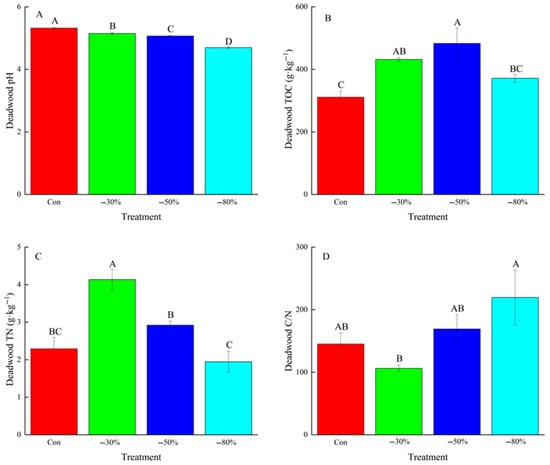
Figure 5.
The impact of reduced precipitation treatments on: (A) Deadwood pH; (B) Deadwood TOC; (C) Deadwood TN; and (D) Deadwood C/N ratio. Different letters indicate statistically significant differences between treatments (p < 0.05), the same applies to the figures below. Bars with different letters indicate significant differences (p < 0.05); absence of letters denotes no significant differences. Error bars indicate standard errors. The bar colors represent reduced precipitation treatments: control (ambient, read), 30% reduction (green), 50% reduction (Dark blue), and 80% reduction (light blue), the same applies to the figures below.
Reduced precipitation treatments exerted significant effects on deadwood lignin content and the lignin/N ratio (p < 0.01). Under ambient precipitation, deadwood exhibited the lowest lignin concentration, significantly lower than that observed in the 30%, 50%, and 80% precipitation reduction treatments (Figure 6A). As precipitation reduction intensified (30%, 50%, 80%), lignin content in deadwood increased significantly (Figure 6A), corroborating our first hypothesis that drought conditions elevate the proportion of recalcitrant components such as lignin. Deadwood cellulose content did not differ significantly among the precipitation reduction treatments; however, it was the lowest under ambient precipitation (Figure 6B). The lignin/N ratio in deadwood was the highest under the 80% reduction treatment, significantly exceeding the ratios observed under the 30% and 50% reductions (Figure 6C).
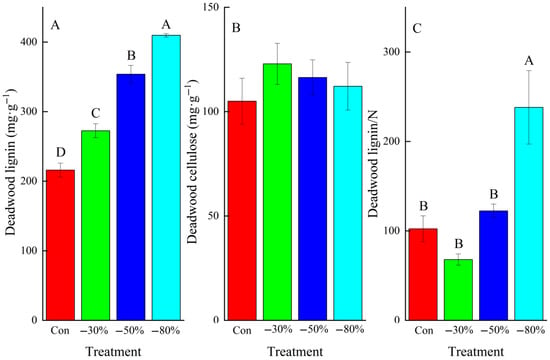
Figure 6.
The impact of reduced precipitation treatments on: (A) Deadwood lignin; (B) Deadwood cellulose; and (C) Deadwood lignin/N. Bars with different letters indicate significant differences (p < 0.05); absence of letters denotes no significant differences. Error bars indicate standard errors.
Reduced precipitation treatments significantly influenced the mass fractions of soluble sugars and NSCs in deadwood (p < 0.01). Under ambient precipitation, deadwood exhibited the lowest soluble sugar content, markedly lower than that under the 30%, 50%, and 80% reduction treatments (Figure 7A). As precipitation reduction intensified (30%, 50%, 80%), the soluble sugar mass fraction in deadwood increased significantly (Figure 7A). Similarly, starch content was the lowest under ambient precipitation and increased progressively with 30%, 50%, and 80% precipitation reductions (Figure 7B). Consequently, the total NSC mass fraction—defined as the sum of soluble sugars and starch—was minimal under ambient conditions and rose significantly across the 30%, 50%, and 80% reduction treatments (Figure 7C). These observations support Hypothesis 1, which posits that NSCs accumulate in deadwood when microbial utilization is constrained by reduced water content.
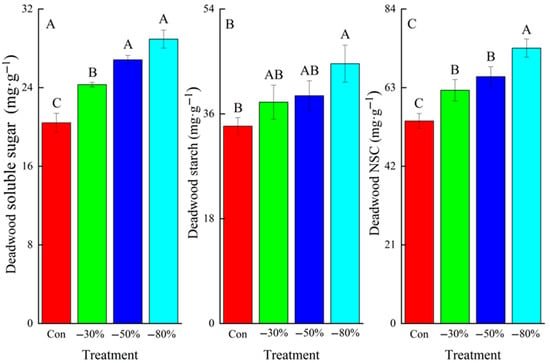
Figure 7.
The impact of reduced precipitation treatments on: (A) Deadwood soluble sugar; (B) Deadwood starch; and (C) Deadwood NSC mass fractions. Bars with different letters indicate significant differences (p < 0.05); absence of letters denotes no significant differences. Error bars indicate standard errors.
3.2. Effects of Reduced Precipitation on Soil Nutrient Content
Reduced precipitation treatments significantly influenced TOC, DOC, and MBC in soils in contact with deadwood (p < 0.01). Under the 80% reduction treatment, soil TOC was at its lowest, showing a significant difference compared to the ambient precipitation control, as well as the 30% and 50% reduction treatments (Figure 8A). Soil DOC was the highest under ambient precipitation, significantly exceeding the values observed in the 30%, 50%, and 80% reduction treatments, and it declined progressively with increasing precipitation reduction (Figure 8B). Conversely, soil MBC was the lowest in the ambient precipitation treatment, significantly lower than in the 30% reduction treatment (Figure 8C). These findings align with Hypothesis 2, which posits that elevated lignin and NSC concentrations in deadwood inhibit soil nutrient accumulation.
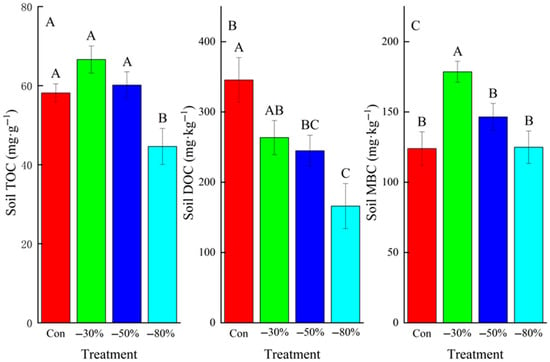
Figure 8.
The impact of reduced precipitation treatments on: (A) Soil TOC; (B) Soil DOC; and (C) Soil MBC. Bars with different letters indicate significant differences (p < 0.05); absence of letters denotes no significant differences. Error bars indicate standard errors.
Furthermore, reduced precipitation treatments significantly affected soil pH, TN, TP, and DON (p < 0.01). The 80% reduction treatment resulted in the highest soil pH, which significantly exceeded the values recorded under the control, 30%, and 50% reduction treatments (Figure 9A). Soil TN was the lowest under the 80% reduction, significantly lower than that under ambient precipitation, as well as the 30% and 50% reductions (Figure 9B). Soil TP peaked under ambient precipitation, significantly higher than in all three reduction treatments, and showed a marked decline as precipitation was reduced (Figure 9C). Similarly, dissolved organic nitrogen was the highest under ambient precipitation, significantly greater than in the 30%, 50%, and 80% reduction treatments (Figure 9D), further supporting Hypothesis 2.
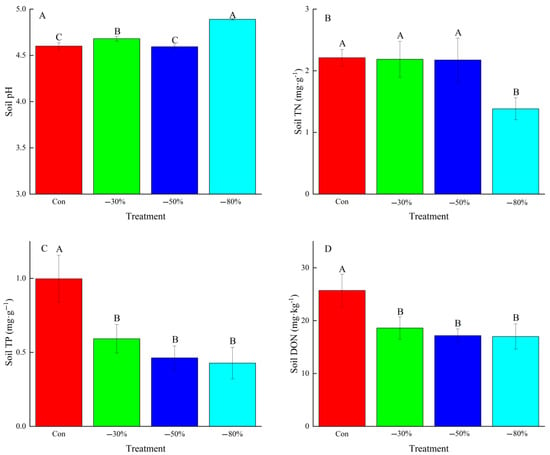
Figure 9.
The impact of reduced precipitation treatments on: (A) Soil pH; (B) Soil TN; (C) Soil TP; and (D) Soil DON. Bars with different letters indicate significant differences (p < 0.05); absence of letters denotes no significant differences. Error bars indicate standard errors.
3.3. Relationship Between Deadwood Substrate Chemistry and Soil Nutrient Content Under Precipitation Reduction
Principal component analysis (PCA) was conducted to investigate the relationships between the chemical properties of deadwood substrates and soil nutrient parameters under various reduced precipitation treatments. The first two principal components (PC1 and PC2) explained 45.4% and 14.4% of the total variance, respectively, together accounting for 59.8% of the sample variation (Figure 10). This indicates that these axes capture the primary shifts in deadwood and soil chemistry across treatments. Samples from the 30% precipitation reduction treatment (squares) clustered on the left side of the ordination, closely aligning with soil TOC, soil water content, and DOC. This suggests that, under mild drought conditions, soil water status and carbon dynamics predominate (Figure 10). Samples from the 50% reduction treatment (circles) occupied the central region, overlapping with soil MBC, deadwood cellulose, and deadwood TOC. This indicates a concurrent response of soil microbial activity and deadwood carbon pools under moderate drought conditions (Figure 10). In contrast, samples from the 80% reduction treatment (triangles) were clustered on the right side, primarily correlating with the contents of deadwood lignin, starch, and soluble sugars. This reflects the accumulation of recalcitrant compounds, such as lignin, and labile carbon sources, including NSCs, under extreme drought conditions (Figure 10). The chemical attributes of deadwood—namely TOC, cellulose, the lignin/N ratio, the C/N ratio, soluble sugars, and starch—exhibited positive loadings on principal component 1 (PC1), with the most pronounced effects occurring under the 80% reduction treatment (Figure 10). Soil nutrient variables, including soil TOC, pH, DOC, DON, and MBC, displayed varying loadings on principal components 1 and 2 (PC1 and PC2), with soil nutrients being predominantly influenced by the 30% and 50% reduction treatments (Figure 10). Soil water content and DOC showed strong loadings on PC2, while deadwood properties such as cellulose and starch were more closely associated with PC1. This indicates that soil water content and organic carbon dynamics primarily drive the variance observed in PC2, whereas the chemical composition of deadwood serves as the main determinant of the variance in PC1 (Figure 10).
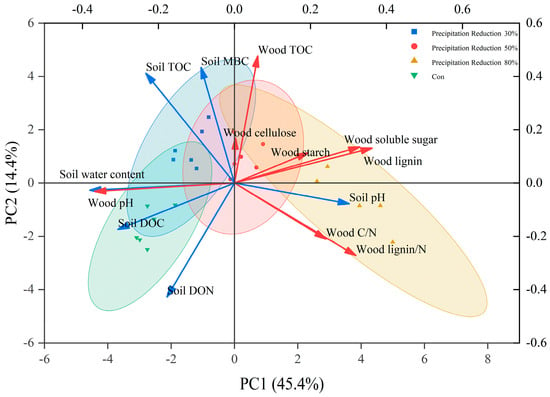
Figure 10.
Principal component analysis of deadwood and soil chemical properties under reduced precipitation treatments. Red arrows represent deadwood substrate chemical properties; blue arrows represent soil chemical properties.
A partial least squares path model (PLS-PM) further quantified these interactions: soil water content exhibited a strong negative correlation with deadwood substrate properties, including soluble sugars, lignin, pH, and TOC, with a correlation coefficient of r = −0.9051 (p < 0.01). This indicates that higher soil water content is associated with lower levels of deadwood soluble sugars, lignin, pH, and TOC (Figure 11). Conversely, deadwood substrate properties also demonstrated a strong negative correlation with soil nutrient parameters, such as soil pH, TOC, DOC, MBC, DON, TN, and TP, with a correlation coefficient of r = −0.8056 (p < 0.01). This suggests that lower levels of deadwood soluble sugars, lignin, pH, and TOC are linked to higher soil nutrient contents (Figure 11). The model achieved a good overall fit (goodness of fit = 0.5968), indicating strong explanatory power (Figure 11). These results support Hypothesis 1, i.e., reduced precipitation significantly decreases soil water content, leading to an increase in the proportion of recalcitrant components (e.g., lignin) and an accumulation of NSCs in deadwood, and Hypothesis 2, i.e., elevated levels of lignin and NSCs in deadwood inhibit the accumulation of soil nutrients.

Figure 11.
Partial least squares path model (PLS-PM) of the effects of precipitation reduction treatment on deadwood substrate and soil nutrients. Red lines indicate positive effects; **: p < 0.01; GOF: goodness-of-fit index.
4. Discussion
4.1. Mechanisms by Which Reduced Precipitation Regulates the Chemical Properties of Deadwood Substrates
Our results show that reduced precipitation significantly changes deadwood chemical properties (pH, TOC, TN, C/N ratio, lignin content, and NSCs) by altering soil water content dynamics, microbial activity, and decomposition processes. Specifically, precipitation reduction caused a notable decline in deadwood pH (Figure 5A), reflecting soil microenvironment acidification and microbial metabolite accumulation. Under drought, enhanced soil aeration accelerates nitrification [30], resulting in nitrate buildup and H+ release that lower deadwood pH. Simultaneously, the inhibition of aerobic decomposers (e.g., white-rot fungi) reduces lignin-degrading enzyme secretion and organic acid (e.g., oxalic acid) production [31,32], indicating that reduced acid buffering via ion exchange or leaching may also affect pH. Deadwood TOC was the lowest under ambient precipitation (Figure 5B), indicating that adequate moisture promotes rapid microbial mineralization of wood carbon, consistent with reports indicating that wet conditions accelerate lignocellulosic decomposition [22,33]. Under reduced precipitation, slower decomposition retains more recalcitrant components (e.g., lignin), thus increasing TOC. The peak in deadwood TN under the 30% reduction treatment (Figure 5C) likely reflects transient enhancement of nitrogen mineralization under mild drought [17]. In contrast, extreme drought (80% reduction) severely impairs microbial function and increases nitrogen immobilization, leading to TN decline. We observed a marked increase in deadwood lignin content with reduced precipitation (Figure 6A), directly due to drought-induced suppression of lignin-degrading enzymes. White-rot fungi require sufficient moisture to secrete lignin peroxidases (e.g., laccases) [34], and drought-induced water limitation constrains enzyme activity and slows lignin degradation. This finding agrees with the results of Talbot et al. [10], who reported that drought significantly reduces lignin decomposition rates. Although deadwood cellulose content did not differ significantly among treatments (Figure 6B), the reduced availability of its degradation products (e.g., glucose) under drought may exacerbate microbial carbon limitation and indirectly affect soil nutrient cycling. Reduced precipitation significantly increased the mass fractions of soluble sugars, starch, and total NSCs in deadwood (Figure 7), indicating decreased microbial utilization of labile carbon under moisture stress. We propose a “carbon retention–release” mechanism in which NSCs accumulate during drought due to incomplete decomposition and are rapidly mobilized upon rewetting, causing transient microbial activity spikes and promoting DOC and DON release [19,35]. The lowest deadwood C/N ratio under the 30% reduction treatment (Figure 5D) likely reflects elevated TN combined with moderate TOC accumulation. In contrast, the C/N ratio sharply increased under the 80% reduction, indicating severe decoupling of carbon retention and nitrogen immobilization under extreme drought [1,36]. These observations together elucidate how precipitation deficits control deadwood chemistry through soil water content–microbe interactions and pave the way for subsequent effects on soil nutrient dynamics.
4.2. Feedback of Deadwood Substrate Decomposition on Soil Nutrient Dynamics Under Reduced Precipitation
Our results show that reduced precipitation significantly alters nutrient pools (TOC, DOC, MBC, pH, TN, TP, and DON) in soils directly adjacent to deadwood. These changes result from soil water content-driven alterations in microbial activity, organic-matter decomposition, and nutrient cycling. Under the 80% precipitation reduction treatment (Figure 8A), soil TOC was significantly lower than in other treatments, likely due to reduced carbon inputs from slowed deadwood decomposition under extreme drought. Austin et al. [37] reported that sufficient soil water content enhances microbial activity and accelerates litter carbon mineralization, whereas drought-induced retention of recalcitrant compounds (e.g., lignin) suppresses carbon release and decreases soil TOC accumulation. Consistent with this trend, DOC declined significantly with reduced precipitation (Figure 8B), indicating that water stress limits microbial access to labile carbon substrates and reduces DOC efflux. Similar observations in temperate forests attribute drought-driven DOC reductions to decreased extracellular enzyme activity and suppressed microbial metabolism [38]. Soil MBC was the lowest under ambient precipitation but increased under the 30% reduction treatment (Figure 8C). Although counterintuitive, this pattern may reflect rapid microbial turnover under ample moisture [39], whereas moderate drought induces metabolic downregulation or dormancy, causing transient MBC accumulation [24]. Soil TN reached its minimum under the 80% reduction treatment (Figure 9B), due to drought-suppressed nitrogen mineralization and increased microbial immobilization. Sinsabaugh et al. [40] noted that moderate drought may transiently promote nitrogen mineralization, whereas extreme water limitation depresses nitrifier activity and reduces bioavailable nitrogen. Soil TP decreased significantly with precipitation reduction (Figure 9C), as phosphorus mineralization depends on soil water content-driven phosphatase activity [41]. Under the 80% reduction treatment (Figure 9A), soil pH markedly increased; this likely results from enhanced nitrification and nitrate accumulation consuming H+, along with reduced leaching of base cations (Ca2+ and Mg2+) under drought [42,43]. Finally, soil dissolved organic nitrogen (DON) peaked under ambient precipitation and declined under drought (Figure 9D), reflecting higher organic-nitrogen mineralization under adequate moisture and reduced protease activity or intensified microbial competition for nitrogen during drought [44].
Principal component analysis (PCA) and partial least squares path modeling (PLS-PM) revealed mechanistic links between deadwood decomposition and soil nutrient responses along the precipitation reduction gradient. PCA showed that samples from the 80% reduction treatment clustered with elevated deadwood lignin, starch, and soluble sugar contents (Figure 10), indicating pronounced decomposition inhibition and the accumulation of recalcitrant lignocellulosic compounds under extreme drought. Since lignin breakdown depends on white-rot fungal lignin peroxidases, which are sensitive to moisture, drought increases the residual lignin fraction [45]. Concurrent NSC accumulation (Figure 7C) likely reflects reduced microbial carbon-use efficiency [46]. This supports the proposed “carbon retention–release” mechanism, whereby accumulated NSCs are rapidly metabolized upon rewetting, triggering transient microbial activity spikes [38]. Samples from the 30% and 50% reduction treatments aligned more closely with ·soil chemical properties (TOC, DOC, and MBC), highlighting the pronounced influence of moderate drought on soil nutrient pools. For example, elevated MBC under the 30% reduction (Figure 8C) may indicate microbial metabolic downregulation or dormancy strategies to survive mild water stress [44]. In contrast, the pronounced TOC decline under the 80% reduction (Figure 8A) reflects severely constrained deadwood decomposition and reduced carbon inputs, consistent with moisture-driven controls on organic-matter mineralization [30,47].
4.3. Mechanistic Pathways by Which Reduced Precipitation Regulates Soil Nutrient Dynamics via Deadwood Chemistry
The PLS-PM model quantitatively identified interactive pathways linking soil water content, deadwood chemistry, and soil nutrient pools. Soil water content was strongly negatively correlated with deadwood chemical properties (r = −0.91, p < 0.01; Figure 11). This indicates that precipitation deficits inhibit deadwood decomposition through soil drying, promoting retention of recalcitrant substrates. This finding supports the results of Talbot et al. [10], who observed substantially reduced lignin decomposition rates under drought. Manzoni et al. [12] proposed a microbial metabolic threshold theory: when soil water potential drops below −1.5 MPa, the carbon cost of extracellular enzyme production exceeds microbial gains, forcing dormancy. Our observed accumulation of starch and soluble sugars under the 80% reduction treatment (Figure 7C) corroborates this mechanism. As microbial carbon-use efficiency declines, labile substrates are assimilated preferentially, while recalcitrant compounds remain undegraded due to insufficient enzyme investment. Deadwood chemistry was also strongly negatively correlated with soil nutrients (r = −0.81, p < 0.01), showing that moisture-driven shifts in deadwood decomposition alter organic-matter mineralization and nutrient availability. The accumulation of recalcitrant compounds reduces carbon release. Concurrently, the suppression of mineralization under drought decreases soil TN and TP (Figure 8B,C). These dynamics align with the “lignin double-edged sword” concept of Austin and Ballaré [37], wherein lignin accrual slows carbon efflux but concurrently impedes nutrient mineralization by reducing substrate accessibility. Furthermore, elevated soil pH under extreme drought (Figure 8A) likely results from enhanced nitrification and reduced leaching of base cations, as documented by Stark and Firestone [43].
In summary, reduced precipitation alters soil water content regimes that govern deadwood chemical transformation, which in turn modulates soil nutrient dynamics. Mild drought may transiently accelerate nitrogen mineralization and enhance nutrient availability, whereas extreme drought decouples carbon–nitrogen cycles and exacerbates nutrient limitation, threatening long-term forest biogeochemical stability. This framework provides critical theoretical insights for predicting forest carbon-sink function and nutrient-cycling responses under future climate scenarios.
This study presents a mechanistic framework to predict how forest carbon and nutrient cycles may respond to future climate change. However, this study has limitations: (1) The two-year duration of the controlled experiment may underestimate the cumulative effects of long-term changes in precipitation. (2) The lack of quantitative analyses of microbial community structure and enzyme activities restricts molecular-level insights into decomposition mechanisms. Future research should combine long-term field monitoring with molecular techniques (e.g., metagenomics and metabolomics) to elucidate the functional responses of lignin-degrading microbiota. Additionally, expanding the geographic and species scope is necessary to evaluate the generality of deadwood decomposition dynamics across forest ecosystems.
5. Conclusions
- (1)
- Soil Water Content Control of Deadwood Substrate Chemistry Properties
Reduced precipitation directly decreased soil water content, thereby inhibiting microbial activity and markedly altering the chemical properties of deadwood substrates. Under drought conditions, deadwood pH declined, and recalcitrant components (e.g., lignin) and NSCs progressively accumulated, resulting in a deceleration of decomposition rates. These observations identify soil moisture as the principal regulator of deadwood chemical transformation and carbon retention.
- (2)
- Feedback of Deadwood Chemical Changes on Soil Nutrient Pools
The accumulation of lignin and NSCs in deadwood was strongly and negatively correlated with soil carbon, nitrogen, and phosphorus stocks. Under mild drought (30% precipitation reduction), transient mineralization of NSCs enhanced soil microbial biomass carbon (MBC); in contrast, extreme drought (80% reduction) persistently suppressed organic-matter mineralization, leading to sustained declines in soil total nitrogen, total phosphorus, and dissolved organic carbon, thereby intensifying nutrient limitation.
Collectively, these findings indicate that drought promotes the retention of recalcitrant substrates and the accumulation of NSCs in deadwood, delays organic-matter transformation, and ultimately constrains soil nutrient release.
Author Contributions
Conceptualization, L.L. (Laicong Luo), X.Y. and Y.L.; methodology, L.L. (Laicong Luo), C.W. and Y.L.; statistical analysis, L.L. (Laicong Luo); writing—original draft preparation, L.L. (Laicong Luo); writing—review and editing, D.Z., X.Z., K.L., X.H., L.L. (Long Li), B.Y., C.L., W.D. and S.L.; funding acquisition, Y.L. All authors have read and agreed to the published version of the manuscript.
Funding
This research was funded by the National Natural Science Foundation of China (32360377).
Data Availability Statement
The original contributions presented in this study are included in the article. Further inquiries can be directed to the corresponding author.
Conflicts of Interest
The authors declare no conflicts of interest.
References
- Knapp, A.K.; Beier, C.; Briske, D.D.; Classen, A.T.; Luo, Y.; Reichstein, M.; Smith, M.D.; Smith, S.D.; Bell, J.E.; Fay, P.A.; et al. Consequences of More Extreme Precipitation Regimes for Terrestrial Ecosystems. BioScience 2008, 58, 811–821. [Google Scholar] [CrossRef]
- Adnan, M.; Badi, W.; Dereczynski, C.; Di Luca, A.; Ghosh, S.; Iskandar, I.; Kossin, J.; Lewis, S.; Otto, F.; Pinto, I.; et al. Weather and Climate Extreme Events in a Changing Climate. In Climate Change 2021—The Physical Science Basis: Working Group I Contribution to the Sixth Assessment Report of the Intergovernmental Panel on Climate Change; Intergovernmental Panel on Climate Change (IPCC); Cambridge University Press: Cambridge, MA, USA, 2023; pp. 1513–1766. ISBN 978-1-009-15788-9. [Google Scholar]
- Allen, C.D.; Macalady, A.K.; Chenchouni, H.; Bachelet, D.; McDowell, N.; Vennetier, M.; Kitzberger, T.; Rigling, A.; Breshears, D.D.; Hogg, E.H.; et al. A Global Overview of Drought and Heat-Induced Tree Mortality Reveals Emerging Climate Change Risks for Forests. For. Ecol. Manag. 2010, 259, 660–684. [Google Scholar] [CrossRef]
- Dijkstra, F.A.; Pendall, E.; Morgan, J.A.; Blumenthal, D.M.; Carrillo, Y.; LeCain, D.R.; Follett, R.F.; Williams, D.G. Climate Change Alters Stoichiometry of Phosphorus and Nitrogen in a Semiarid Grassland. New Phytol. 2012, 196, 807–815. [Google Scholar] [CrossRef] [PubMed]
- Vicca, S.; Bahn, M.; Estiarte, M.; van Loon, E.E.; Vargas, R.; Alberti, G.; Ambus, P.; Arain, M.A.; Beier, C.; Bentley, L.P.; et al. Can Current Moisture Responses Predict Soil CO2 Efflux under Altered Precipitation Regimes? A Synthesis of Manipulation Experiments. Biogeosciences 2014, 11, 2991–3013. [Google Scholar] [CrossRef]
- Ferreira, V.; Graça, M.A.S.; Elosegi, A. A Meta-Analysis of Drought Effects on Litter Decomposition in Streams. Hydrobiologia 2023, 850, 1715–1735. [Google Scholar] [CrossRef]
- Wu, Q.; Peñuelas, J.; Yue, K.; Zhou, Z.; Peng, Y.; Heděnec, P.; Zhang, H.; Ji, Y.; Ma, N.; Chang, S.X.; et al. Asymmetric Responses of Litter Decomposition to Altered Precipitation: Double Evidence from Field Experiments and Global Synthesis. TIG 2025, 3, 100117. [Google Scholar] [CrossRef]
- Bradford, M.A.; Warren II, R.J.; Baldrian, P.; Crowther, T.W.; Maynard, D.S.; Oldfield, E.E.; Wieder, W.R.; Wood, S.A.; King, J.R. Climate Fails to Predict Wood Decomposition at Regional Scales. Nat. Clim. Change 2014, 4, 625–630. [Google Scholar] [CrossRef]
- Magnússon, R.Í.; Tietema, A.; Cornelissen, J.H.C.; Hefting, M.M.; Kalbitz, K. Tamm Review: Sequestration of Carbon from Coarse Woody Debris in Forest Soils. For. Ecol. Manag. 2016, 377, 1–15. [Google Scholar] [CrossRef]
- Talbot, J.M.; Yelle, D.J.; Nowick, J.; Treseder, K.K. Litter Decay Rates Are Determined by Lignin Chemistry. Biogeochemistry 2012, 108, 279–295. [Google Scholar] [CrossRef]
- Kaspari, M.; Garcia, M.N.; Harms, K.E.; Santana, M.; Wright, S.J.; Yavitt, J.B. Multiple Nutrients Limit Litterfall and Decomposition in a Tropical Forest. Ecol. Lett. 2008, 11, 35–43. [Google Scholar] [CrossRef]
- Manzoni, S.; Schimel, J.P.; Porporato, A. Responses of Soil Microbial Communities to Water Stress: Results from a Meta-analysis. Ecology 2012, 93, 930–938. [Google Scholar] [CrossRef]
- Van Geffen, K.G.; Poorter, L.; Sass-Klaassen, U.; Van Logtestijn, R.S.P.; Cornelissen, J.H.C. The Trait Contribution to Wood Decomposition Rates of 15 Neotropical Tree Species. Ecology 2010, 91, 3686–3697. [Google Scholar] [CrossRef] [PubMed]
- Wang, Q.; Wang, S.; Huang, Y. Comparisons of Litterfall, Litter Decomposition and Nutrient Return in a Monoculture Cunninghamia Lanceolata and a Mixed Stand in Southern China. For. Ecol. Manag. 2008, 255, 1210–1218. [Google Scholar] [CrossRef]
- Gao, S.; Cai, Z.-Y.; Yang, C.-C.; Luo, J.-X.; Zhang, S. Provenance-Specific Ecophysiological Responses to Drought in Cunninghamia Lanceolata. J. Plant Ecol. 2021, 14, 1060–1072. [Google Scholar] [CrossRef]
- Floudas, D.; Binder, M.; Riley, R.; Barry, K.; Blanchette, R.A.; Henrissat, B.; Martínez, A.T.; Otillar, R.; Spatafora, J.W.; Yadav, J.S.; et al. The Paleozoic Origin of Enzymatic Lignin Decomposition Reconstructed from 31 Fungal Genomes. Science 2012, 336, 6089. [Google Scholar] [CrossRef]
- Borken, W.; Matzner, E. Reappraisal of Drying and Wetting Effects on C and N Mineralization and Fluxes in Soils. Glob. Change Biol. 2009, 15, 808–824. [Google Scholar] [CrossRef]
- Peng, L.; Hao, G.; Liu, H.; Shen, H.; Zhou, X.; Zang, Y.; Zhang, J.; Zhang, Y. Impacts of Groundwater Depth and Tree Age on the Non-Structural Carbohydrates of Haloxylon Ammodendron. Plant Stress 2024, 14, 100659. [Google Scholar] [CrossRef]
- Hao, B.; Hartmann, H.; Li, Y.; Liu, H.; Shi, F.; Yu, K.; Li, X.; Li, Z.; Wang, P.; Allen, C.D.; et al. Precipitation Gradient Drives Divergent Relationship between Non-Structural Carbohydrates and Water Availability in Pinus Tabulaeformis of Northern China. Forests 2021, 12, 133. [Google Scholar] [CrossRef]
- Yang, H.; Ciais, P.; Chave, J.; Huang, Y.; Ballantyne, A.; Yu, K.; Berzaghi, F.; Wigneron, J.-P. Coarse Woody Debris Are Buffering Mortality-Induced Carbon Losses to the Atmosphere in Tropical Forests. Environ. Res. Lett. 2021, 16, 011006. [Google Scholar] [CrossRef]
- Tláskal, V.; Brabcová, V.; Větrovský, T.; Jomura, M.; López-Mondéjar, R.; Oliveira Monteiro, L.M.; Saraiva, J.P.; Human, Z.R.; Cajthaml, T.; Nunes da Rocha, U.; et al. Complementary Roles of Wood-Inhabiting Fungi and Bacteria Facilitate Deadwood Decomposition. mSystems 2021, 6, 1128. [Google Scholar] [CrossRef]
- Harmon, M.E.; Franklin, J.F.; Swanson, F.J.; Sollins, P.; Gregory, S.V.; Lattin, J.D.; Anderson, N.H.; Cline, S.P.; Aumen, N.G.; Sedell, J.R.; et al. Ecology of Coarse Woody Debris in Temperate Ecosystems. Adv. Ecol. Res. 1986, 15, 133–302. [Google Scholar] [CrossRef]
- López-Mondéjar, R.; Zühlke, D.; Becher, D.; Riedel, K.; Baldrian, P. Cellulose and Hemicellulose Decomposition by Forest Soil Bacteria Proceeds by the Action of Structurally Variable Enzymatic Systems. Sci. Rep. 2016, 6, 25279. [Google Scholar] [CrossRef]
- Schimel, J.P. Life in Dry Soils: Effects of Drought on Soil Microbial Communities and Processes. Annu. Rev. Ecol. Evol. Syst. 2018, 49, 409–432. [Google Scholar] [CrossRef]
- Wild, B.; Schnecker, J.; Alves, R.J.E.; Barsukov, P.; Bárta, J.; Čapek, P.; Gentsch, N.; Gittel, A.; Guggenberger, G.; Lashchinskiy, N.; et al. Input of Easily Available Organic C and N Stimulates Microbial Decomposition of Soil Organic Matter in Arctic Permafrost Soil. Soil Biol. Biochem. 2014, 75, 143–151. [Google Scholar] [CrossRef] [PubMed]
- Chen, T.; Meunier, F.; Peaucelle, M.; Tang, G.; Yuan, Y.; Verbeeck, H. Elevated Atmospheric CO2 Concentration and Vegetation Structural Changes Contributed to Gross Primary Productivity Increase More than Climate and Forest Cover Changes in Subtropical Forests of China. Biogeosciences 2024, 21, 2253–2272. [Google Scholar] [CrossRef]
- Rowland, A.P.; Roberts, J.D. Lignin and Cellulose Fractionation in Decomposition Studies Using Acid-detergent Fibre Methods. Commun. Soil Sci. Plant Anal. 1994, 25, 269–277. [Google Scholar] [CrossRef]
- Liang, K.; Fan, Y.; Feng, H.; Tan, T.; Shi, J. Concentration and Distribution Pattern of Non-Structural Carbohydrate of Phyllostachys Glauca in Different Limestone Habitats. Sci. Silvae Sin. 2019, 55, 22–27. [Google Scholar]
- Vance, E.D.; Brookes, P.C.; Jenkinson, D.S. An Extraction Method for Measuring Soil Microbial Biomass C. Soil Biol. Biochem. 1987, 19, 703–707. [Google Scholar] [CrossRef]
- Davidson, E.A.; Verchot, L.V.; Cattânio, J.H.; Ackerman, I.L.; Carvalho, J.E.M. Effects of Soil Water Content on Soil Respiration in Forests and Cattle Pastures of Eastern Amazonia. Biogeochemistry 2000, 48, 53–69. [Google Scholar] [CrossRef]
- Mäkelä, M.R.; Sietiö, O.-M.; De Vries, R.P.; Timonen, S.; Hildén, K. Oxalate-Metabolising Genes of the White-Rot Fungus Dichomitus Squalens Are Differentially Induced on Wood and at High Proton Concentration. PLoS ONE 2014, 9, e87959. [Google Scholar] [CrossRef]
- Hofrichter, M. Review: Lignin Conversion by Manganese Peroxidase (MnP). Enzym. Microb. Technol. 2002, 30, 454–466. [Google Scholar] [CrossRef]
- Weedon, J.T.; Cornwell, W.K.; Cornelissen, J.H.C.; Zanne, A.E.; Wirth, C.; Coomes, D.A. Global Meta-Analysis of Wood Decomposition Rates: A Role for Trait Variation among Tree Species? Ecol. Lett. 2009, 12, 45–56. [Google Scholar] [CrossRef] [PubMed]
- Baldrian, P. Fungal Laccases—Occurrence and Properties. FEMS Microbiol. Rev. 2006, 30, 215–242. [Google Scholar] [CrossRef] [PubMed]
- Peltier, D.M.P.; Carbone, M.S.; McIntire, C.D.; Robertson, N.; Thompson, R.A.; Malone, S.; LeMoine, J.; Richardson, A.D.; McDowell, N.G.; Adams, H.D.; et al. Carbon Starvation Following a Decade of Experimental Drought Consumes Old Reserves in Pinus Edulis. New Phytol. 2023, 240, 92–104. [Google Scholar] [CrossRef] [PubMed]
- Hoover, D.L.; Rogers, B.M. Not All Droughts Are Created Equal: The Impacts of Interannual Drought Pattern and Magnitude on Grassland Carbon Cycling. Glob. Change Biol. 2016, 22, 1809–1820. [Google Scholar] [CrossRef]
- Austin, A.T.; Ballaré, C.L. Dual Role of Lignin in Plant Litter Decomposition in Terrestrial Ecosystems. Proc. Natl. Acad. Sci. USA 2010, 107, 4618–4622. [Google Scholar] [CrossRef]
- Borken, W.; Davidson, E.A.; Savage, K.; Gaudinski, J.; Trumbore, S.E. Drying and Wetting Effects on Carbon Dioxide Release from Organic Horizons. Soil Sci. Soc. Am. J. 2003, 67, 1888–1896. [Google Scholar] [CrossRef]
- Blagodatskaya, E.; Kuzyakov, Y. Active Microorganisms in Soil: Critical Review of Estimation Criteria and Approaches. Soil Biol. Biochem. 2013, 67, 192–211. [Google Scholar] [CrossRef]
- Sinsabaugh, R.L.; Lauber, C.L.; Weintraub, M.N.; Ahmed, B.; Allison, S.D.; Crenshaw, C.; Contosta, A.R.; Cusack, D.; Frey, S.; Gallo, M.E.; et al. Stoichiometry of Soil Enzyme Activity at Global Scale. Ecol. Lett. 2008, 11, 1252–1264. [Google Scholar] [CrossRef]
- Sardans, J.; Peñuelas, J.; Ogaya, R. Drought-Induced Changes in C and N Stoichiometry in a Quercus Ilex Mediterranean Forest. For. Sci. 2008, 54, 513–522. [Google Scholar] [CrossRef]
- Bolan, N.S.; Adriano, D.C.; Curtin, D. Soil Acidification and Liming Interactions with Nutrientand Heavy Metal Transformationand Bioavailability. Adv. Agron. 2003, 78, 215–272. [Google Scholar]
- Stark, J.M.; Firestone, M.K. Mechanisms for Soil Moisture Effects on Activity of Nitrifying Bacteria. Appl. Environ. Microbiol. 1995, 61, 218–221. [Google Scholar] [CrossRef] [PubMed]
- Schimel, J.; Balser, T.C.; Wallenstein, M. Microbial Stress-Response Physiology and Its Implications for Ecosystem Function. Ecology 2007, 88, 1386–1394. [Google Scholar] [CrossRef] [PubMed]
- Lodge, D.J.; Van Beusekom, A.E.; González, G.; Sánchez-Julia, M.; Stankavich, S. Disturbance Reduces Fungal White-Rot Litter Mat Cover in a Wet Subtropical Forest. Ecosphere 2022, 13, e3936. [Google Scholar] [CrossRef]
- Gessler, A.; Schaub, M.; McDowell, N.G. The Role of Nutrients in Drought-Induced Tree Mortality and Recovery. New Phytol. 2017, 214, 513–520. [Google Scholar] [CrossRef]
- Lajtha, K.; Bowden, R.D.; Crow, S.; Fekete, I.; Kotroczó, Z.; Plante, A.; Simpson, M.J.; Nadelhoffer, K.J. The Detrital Input and Removal Treatment (DIRT) Network: Insights into Soil Carbon Stabilization. Sci. Total Environ. 2018, 640, 1112–1120. [Google Scholar] [CrossRef]
Disclaimer/Publisher’s Note: The statements, opinions and data contained in all publications are solely those of the individual author(s) and contributor(s) and not of MDPI and/or the editor(s). MDPI and/or the editor(s) disclaim responsibility for any injury to people or property resulting from any ideas, methods, instructions or products referred to in the content. |
© 2025 by the authors. Licensee MDPI, Basel, Switzerland. This article is an open access article distributed under the terms and conditions of the Creative Commons Attribution (CC BY) license (https://creativecommons.org/licenses/by/4.0/).